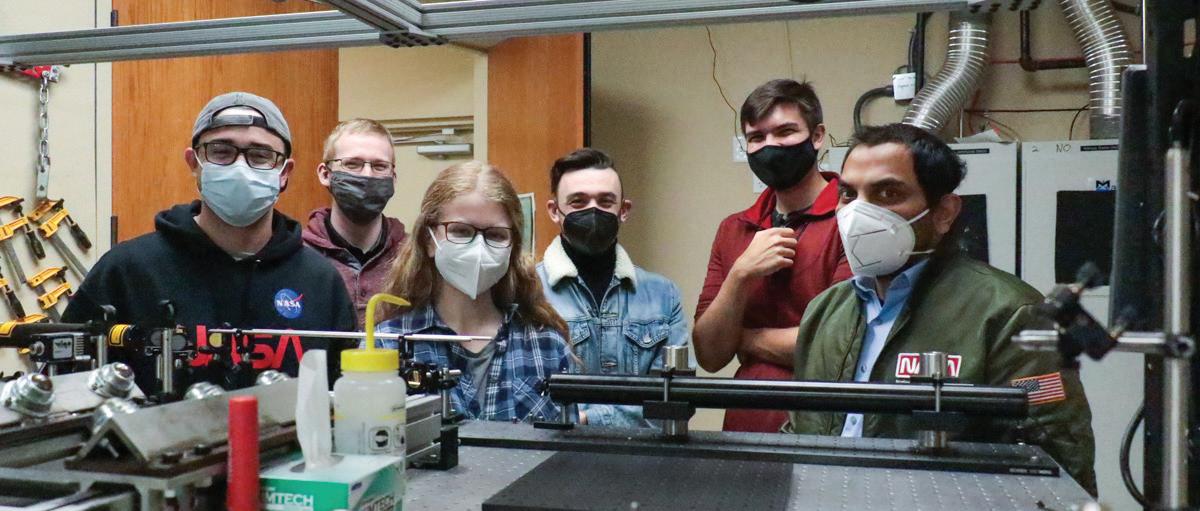
4 minute read
The Jet Set
UCF Leads $10M NASA Project to Develop Zero-Carbon Jet Engines

Professor Subith Vasu (far right) with his student researchers.
Advertisement
UCF is developing new technology that is expected to make airplane engines emission free, potentially revolutionizing the aviation industry.
UCF put together a team of experts and stakeholders to evaluate their innovation, which aims to not only make aviation fuel green, but also create engines and fueling systems that easily integrate into current airport infrastructure thus saving airports and aircraft manufacturers millions of dollars as they look to retrofit.
“We don’t want to create something that will be too cumbersome and expensive to implement,” says Jay Kapat, the lead investigator and the director of the UCF Center for Advanced Turbomachinery and Energy Research. “If we want people to adopt this green tech, it needs to be scalable. To adopt hydrogen, for example, we can’t expect every airport to set up large cryogenic liquid hydrogen systems like Kennedy Space Center. That’s unreasonable.”
With this practical approach, Kapat put together a team of experts from UCF, Georgia Tech and Purdue and with industry experts from Boeing, General Electric, ANSYS, Southwest Research Institute and the Greater Orlando Aviation Authority. The team landed a $10 million five-year NASA University Leadership Initiative grant to get the ball rolling.
“We have a good concept,” Kapat says. “And by having our partners in industry we know we’ll fine tune and be ready for technology transition, so we can provide a greener future for our children.”
Developing Jet Engines Kapat and several of his UCF colleagues in engineering and the Florida Space Institute propose using liquid ammonia (NH3) as the fuel for aircraft which, upon combustion, will produce harmless emissions that are green while still providing enough power to keep the aircraft aloft. At high altitudes, ammonia is naturally liquid thereby limiting the need for special handling. Airports and airplanes are expected to store the ammonia in fuel tanks. Ammonia is commonly used as a fertilizer and, when mixed with water, in some household cleaners.
Ammonia will be the hydrogen carrier, which will be catalytically “cracked” to release nitrogen and hydrogen. The hydrogen will be burned in the onboard combustors (inside the engine) to provide the power. Airports and aircraft are expected to store the NH3 in fuel tanks. Excess NH3 will then be used to catalytically reduce any NOx left in the exhaust converting it to nitrogen and water.
When the hydrogen is released, there will be an added bonus, Kapat explained. The conversion process also provides cooling, which can be used to keep engines from overheating and burning out. The impact may be better engine performance and efficiency. Engine exhaust heat is then converted back to electricity for onboard use, thus reducing power draw from the core engines.
The team also is developing new components for jet engines to be used in conjunction with the new fuel. The team is using the 737-8 class for a baseline as it represents nearly a quarter of all commercial aircraft, according to Boeing.
The Research Team
“This project would not have been possible without our internal and external partners,” Kapat says.
Catalyst development and improvement of known catalysis pathways are key to the UCF effort and will be undertaken in Professor Richard Blair’s laboratory at the Florida Space Institute. Aerospace engineering Professor Subith Vasu will lead the efforts to design tools, computer models and combustion testing from his lab. Kapat will lead a team that will conduct thermal management and system integration at CATER. UCF Chemical Safety and Security Coordinator Sandra Hick will oversee safety and occupational health issues that are central to any use of ammonia and hydrogen.
Georgia Tech will provide its aviation simulation expertise and Purdue is providing some of its unique labs and expertise in combustion and aerodynamics. Boeing is providing the integration know-how to the aircraft, and GE is contributing its knowledge
of the jet engines. Other industry partners are advising on large scale simulation, the feasibility of the technology in the real world and providing a pathway for technology transition. Student training and workforce development are also key aspects of the overall project. Several UCF students working under faculty in the various labs will contribute to the research.
Kapat is a recognized expert in energy research. He leads CATER, which has brought together experts who are solving some of the most complex research problems in turbomachinery for power generation, aviation, and space propulsion. Kapat has multiple degrees including a doctorate in mechanical engineering from Massachusetts Institute of Technology. He is a fellow of the American Society of Mechanical Engineers, and an American Institute of Aeronautics and Astronautics Associate fellow.
Written by Zenaida Gonzalez Kotala. Photos by Karen Norum.










